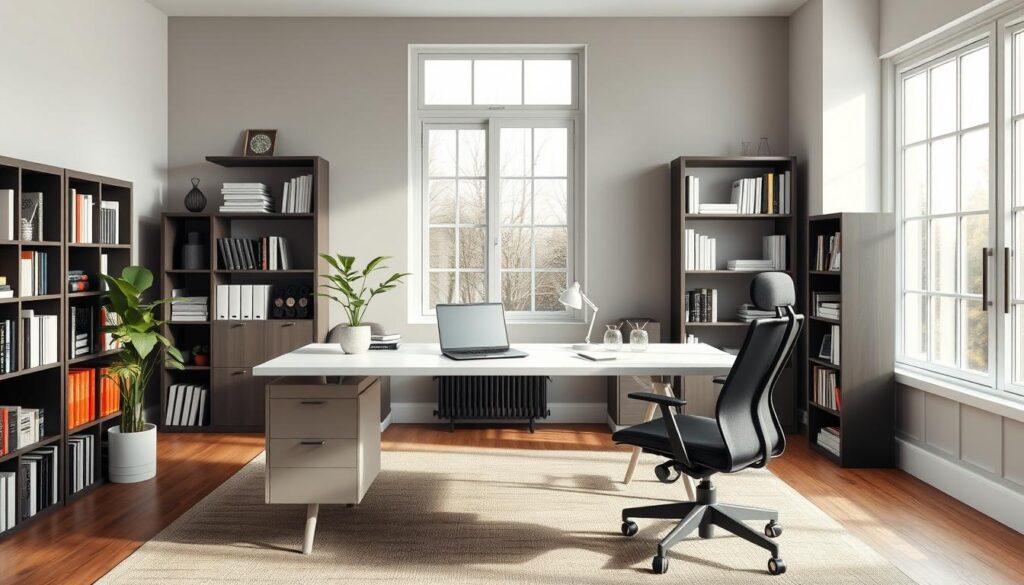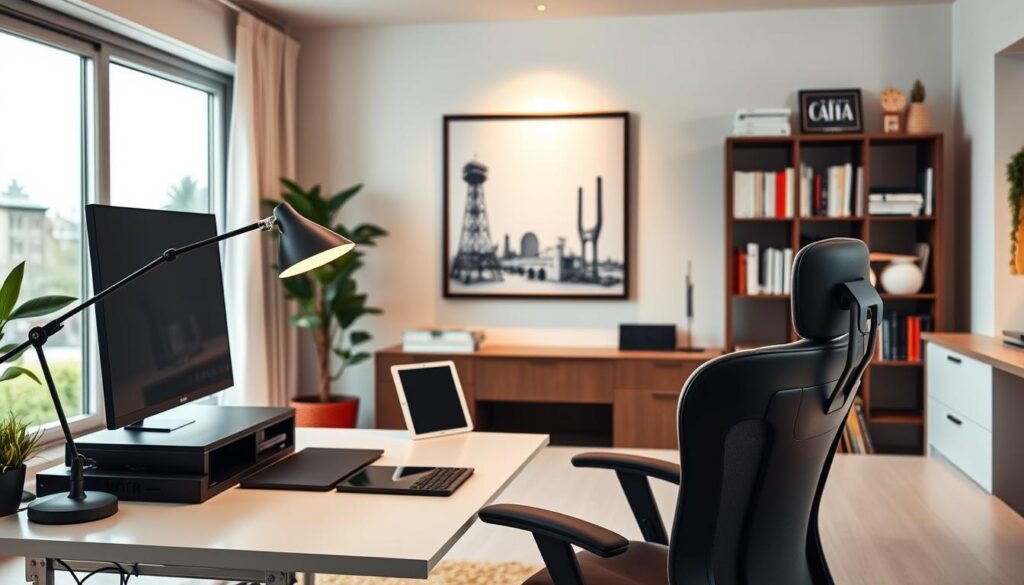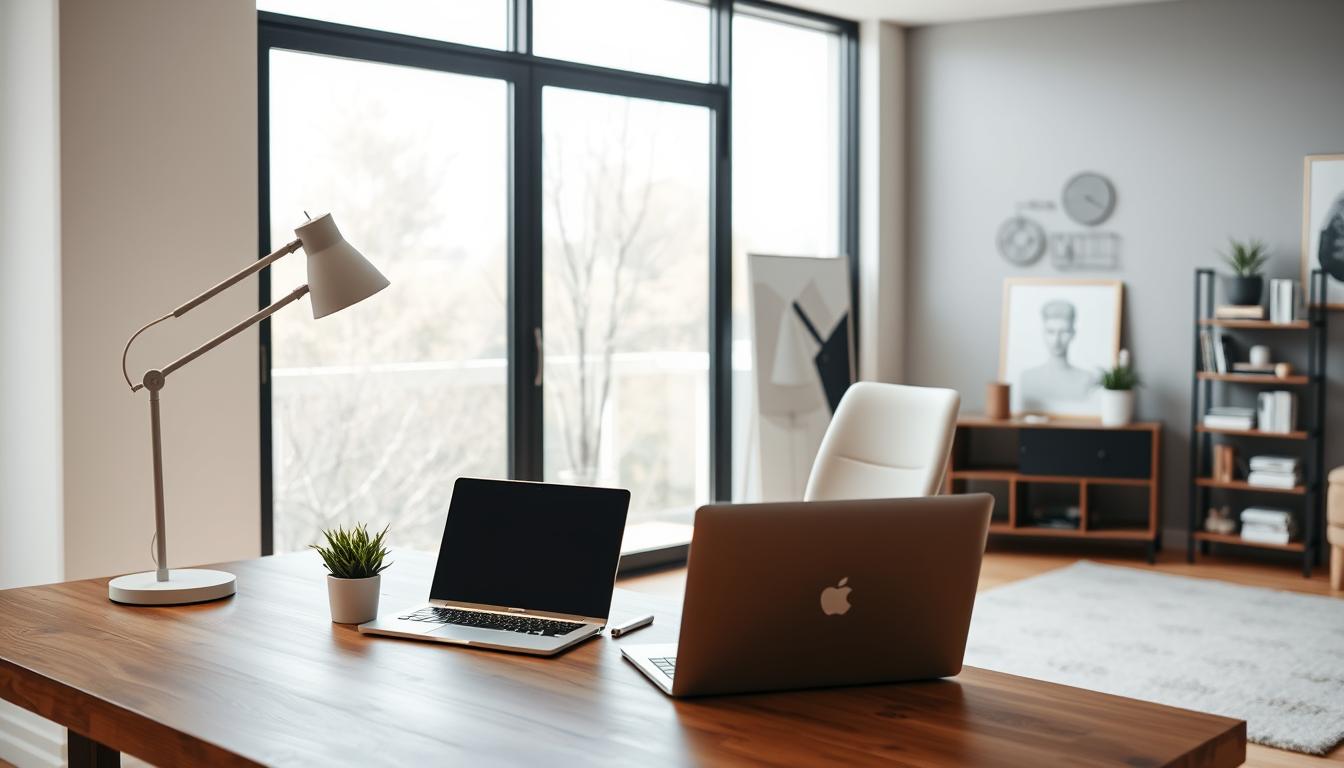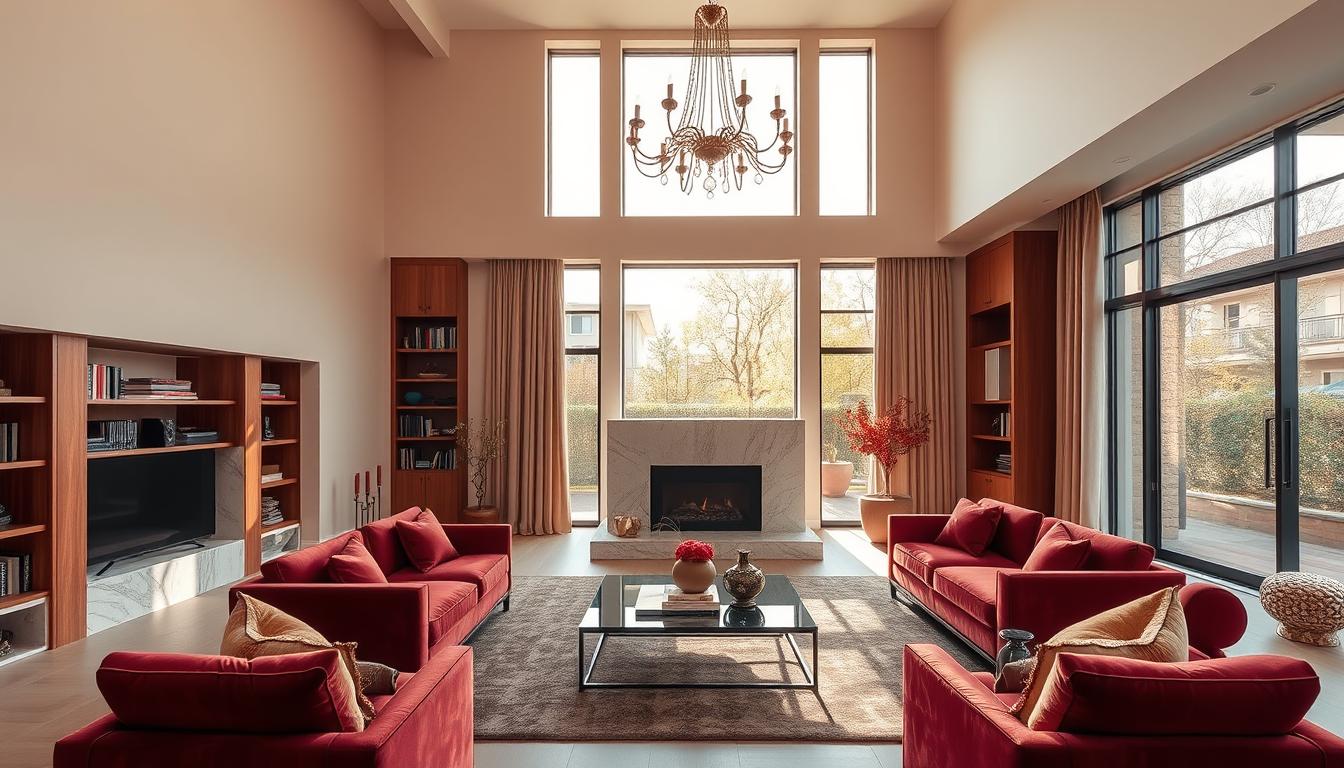More people are working from home now. Creating a good workspace is key. Experts say a well-designed space can make you more productive and comfortable.
Katie Schroder from Atelier Interior Design says it’s important to make the office your own. This makes your space both useful and motivating.
We’ll look at how to make a home office great. We’ll cover important parts for a space that boosts your creativity and work. You’ll get home office decor inspiration and useful advice.
Key Takeaways
- Create a workspace that reflects your personal style.
- Choose furniture that is both functional and comfortable.
- Incorporate elements that inspire creativity and productivity.
- Consider the lighting and color scheme of your workspace.
- Make use of storage solutions to maintain a clutter-free environment.
Understanding the Importance of Home Office Design
Home office design is very important. It affects how well we work and how we feel. A good home office helps us balance work and personal life, which is key in today’s remote work world.
Enhancing Productivity and Comfort
A home office should be both productive and comfy. Niki Brantmark says it should be practical, ergonomic, comfy, and clean. Use ergonomic office furniture and a layout that helps you stay comfortable and avoid eye strain.
For tips on making a home office work well, check out 5 steps to create a functional & aesthetic small home office.
Think about the impact of colors too. Colors can make you more creative or help you focus better.
| Design Element | Impact on Productivity | Impact on Comfort |
|---|---|---|
| Ergonomic Furniture | Improves focus and efficiency | Reduces physical discomfort |
| Natural Light | Boosts mood and energy | Creates a welcoming atmosphere |
| Minimalist Decor | Reduces distractions | Promotes a sense of calm |
Reflection of Personal Style
Our home office should show our style. Adding personal touches like art, plants, or collectibles makes it more fun to work there.
Creating a Professional Environment
If you meet clients or work with others online, a professional space is essential. Choose the right furniture, ensure good lighting, and keep it tidy. A professional home office boosts our credibility and helps us work better.
By focusing on these points, we can make a home office that’s both useful and comfy. It should also show our style and professionalism, improving our work life.
Assessing Our Space and Needs
Before we start designing our home office, we need to check the space we have. We also need to know what we really need. This step is key to making a workspace that works well.
Evaluating Available Space
First, we measure the room set aside for our home office. We should think about its size, layout, and any special features like windows or built-in shelves. Getting the measurements right is important for a space that’s both cozy and useful.
Zoe Feldman of Zoe Feldman Design says a home office doesn’t need a lot of room. With clever storage and furniture that does more than one thing, even tiny spaces can be made to work well. This is really important for interior design for small home offices, where using space wisely is key.
Identifying Functional Requirements
Then, we figure out what we need our home office for. Will we be working on a computer, keeping files, or meeting with people? Knowing what we need helps us focus on the design. For example, if we’re on a lot of calls, we might need to add soundproofing or a quiet spot.
Thinking about how we work every day is also important. We might want to set up different areas for different tasks. This can help us work better.
Considering Future Needs
When we’re looking at our space and needs, we should also think about the future. Will our work habits or needs change soon? Maybe we’ll need more room for files or a bigger area for new tools. Planning for these changes helps us create a home office that will still work well later on.
Staying up-to-date with home office makeover trends can also give us ideas for a modern and flexible space. This way, our home office can grow with us.
Choosing the Right Color Palette
The colors we pick for our home office greatly affect our mood and productivity. A good color palette does more than look nice. It helps us stay focused, creative, and comfortable.
Impact of Colors on Mood and Productivity
Colors shape our feelings and actions. Blue brings calm and trust, while green boosts balance. When picking colors for our office, think about our work and how colors help us stay productive.
Experts like Emily Murray say to choose colors that feel right to us, not just follow trends. This makes our office decor personal and lasting.
Suggestions for Calming Colors
For a calm and focused office, try these colors:
- Soft blues and pale greens for a soothing feel.
- Neutral tones like beige or light gray for a clean look.
- Muted earth tones for warmth and coziness.
Use these colors for walls, furniture, and decor. They help create a stylish and organized office.
Integrating Accent Colors
Calming colors are the base, but accent colors add personality. Accent colors should match the main colors and make the space look better. For example, a blue main color can be paired with yellow or orange for creativity.
Choosing our colors wisely makes our office both useful and a reflection of us. It’s a perfect mix of style and function.
Selecting Appropriate Furniture
The furniture we pick for our home office greatly affects our work. Katie Schroder says a big desk and lots of storage are key. Also, ergonomic furniture is a must for comfort and doing well at work.
Essential Office Furniture Pieces
When setting up a home office, start with the basics. A strong desk and a comfy, ergonomic chair are the core of a good workspace. A desk with cable management helps keep things tidy.
- A spacious desk for working and spreading out documents
- A comfortable, ergonomic chair for long working hours
- Ample storage for office supplies and documents
Ergonomic Options for Comfort
Ergonomic furniture helps avoid body strain, making work more comfortable and safer. Look for chairs that adjust height and have lumbar support. Also, think about a standing desk to switch between sitting and standing.
Key Ergonomic Features:
| Furniture | Ergonomic Feature | Benefit |
|---|---|---|
| Ergonomic Chair | Adjustable Height and Lumbar Support | Reduces back strain and promotes good posture |
| Standing Desk | Adjustable Height | Allows for switching between sitting and standing |
Maximizing Space with Multi-functional Furniture
In smaller home offices, using space wisely is key. Furniture that does more than one thing, like a desk with storage or a file cabinet that’s also a shelf, helps keep things neat and organized.
Think about adding multi-functional items, like a storage ottoman or a wall-mounted shelf. These can help keep your home office clean and useful.
Lighting Options for Our Home Office
The right lighting can turn our home office into a productive haven. Good lighting does more than just light up our space. It also affects our comfort and how well we work.
Importance of Natural Light
Natural light is the best for any workspace, including our home office. It saves energy and boosts our mood and productivity. Hayley Francis says natural light makes a space feel bigger and more welcoming.
To get the most natural light, place our workspace near a window. Use sheer curtains to filter the light and avoid glare on our computer screen.
Choosing Artificial Lighting Fixtures
Artificial lighting is needed when natural light isn’t enough. We have many options like overhead lights, desk lamps, and floor lamps. When picking artificial lighting, think about the light’s color temperature.
Cool white light (3500K-5000K) is great for detailed tasks. Warm white light (2700K-3000K) makes the space cozy.
Layering Light for Versatility
A good lighting setup layers different lights for the right feel and function. Mix overhead lighting with task lighting like desk lamps. This lets us change the light for different tasks, like computer work or reading.
Layering light also cuts down on eye strain by focusing light where it’s needed. By mixing natural and artificial light, we make our home office both useful and nice to look at. This makes our work space more comfortable and productive.
Organizing and Decluttering Our Workspace
Keeping our workspace organized is key to a productive and stylish home office. A tidy area boosts our efficiency and makes work more enjoyable.
Maximizing Productivity through Organization
Good organization is crucial for a home office that works well. By setting up a system, we keep our space neat and efficient. This means sorting tasks, using storage, and keeping things clean.
Carly Callahan stresses the importance of good storage. We can use filing cabinets, shelves, and desk organizers to keep things tidy.
Implementing Effective Storage Solutions
To improve storage, we can use under-desk drawers, wall shelves, and stackable containers. These not only keep our space organized but also make it look better.
- Use wall space with shelves and storage units.
- Choose furniture that offers storage.
- Keep essentials within reach and store less used items in labeled containers.

Embracing Minimalist Design Principles
Minimalist design can greatly improve our home office’s look. It leads to a clean, organized, and attractive space that boosts productivity and creativity.
To get a minimalist vibe, focus on simplicity, clean lines, and a few colors. Add decor that shows our personality without cluttering the space.
By mixing good organization with minimalist design, we can have a home office that’s both useful and stylish. It will reflect the latest home office makeover trends.
Adding Personal Touches and Decoration
To make a home office inspiring, we need to add personal touches and thoughtful decor. Our workspace should be both functional and show our personality and style.
Choosing Artwork and Decor
Choosing the right artwork and decor can really make our home office better. Experts like Dabito say to fill the office with vibrant art to energize it. We can pick pieces that speak to us, like paintings, prints, or sculptures, to make our space unique and inspiring.
When picking decor, think about our personal style and the look we want. For a modern home office styling, sleek, minimalist decor works well. But a traditional office might have classic pieces.
Incorporating Plants for Freshness
Adding plants to our home office brings freshness and texture, making it feel more welcoming. Plants are not just pretty; they also purify the air and help reduce stress.
For busy people, low-maintenance plants like succulents or air plants are great. If we love gardening, we can pick a variety of plants to make our office lush and vibrant.
Selecting Functional Accessories
Functional accessories are key for a well-designed home office. We should find items that are useful and match our decor. For instance, a stylish desk lamp provides light and adds to the look.
Other useful accessories include storage, ergonomic furniture, and tech gadgets. By picking items that are both useful and stylish, we can make our office both productive and beautiful.
By adding these elements, we can make a home office that’s not just functional but also shows our personal style. It gives us home office decor inspiration for our workdays.
Technology and Equipment Considerations
The right tech and equipment are key for a home office. They affect our productivity and work experience. It’s important to pick tools that help us stay organized and efficient.
Essential Tech for Home Office Functionality
To make our home office work well, we need the right tech. This includes:
- Reliable Computer and Internet: A fast computer and stable internet are crucial for any home office.
- Task Lighting: Good lighting helps avoid eye strain and keeps us focused. LED desk lamps are bright and energy-saving.
- Comfortable Desk Chair: A good chair is essential for posture and avoiding back pain.
- Noise-Cancelling Headphones: These help block out distractions, making it easier to concentrate.

Cable Management Solutions
Keeping cables organized is vital for a tidy home office. Here’s how:
- Use cable ties or zip ties to keep cables tidy and untangled.
- Get a cable management box to hide cables and keep things clean.
- Label cables so you can tell which one goes where.
Future-Proofing Our Technology
Choosing tech that lasts is important for our home office. Think about:
- Scalability: Pick tech that can grow or change easily, like modular parts.
- Compatibility: Make sure new tech works with what you already have to avoid problems.
- Emerging Trends: Keep up with new tech and trends that might affect your work, like remote tools.
By focusing on these points, we can build a home office that’s productive and ready for the future.
Maintaining Our Home Office Aesthetics
To keep our home office both productive and inspiring, regular maintenance is key. This means updating our decor to match the latest trends and keeping our organization systems both stylish and useful.
Refreshing Our Space
Experts say that regular updates and seasonal changes are important. Adding new artwork or plants can make our space feel alive and welcoming.
Maintaining a Clean Environment
Keeping our home office clean is essential for staying productive. A regular cleaning schedule and stylish storage solutions help keep things tidy. This follows the principles of stylish home office organization.
Achieving Balance in Design
It’s important to balance work and comfort in our home office design. Choosing furniture that is both functional and comfortable helps. This way, we create a space that supports our well-being and boosts our productivity.


